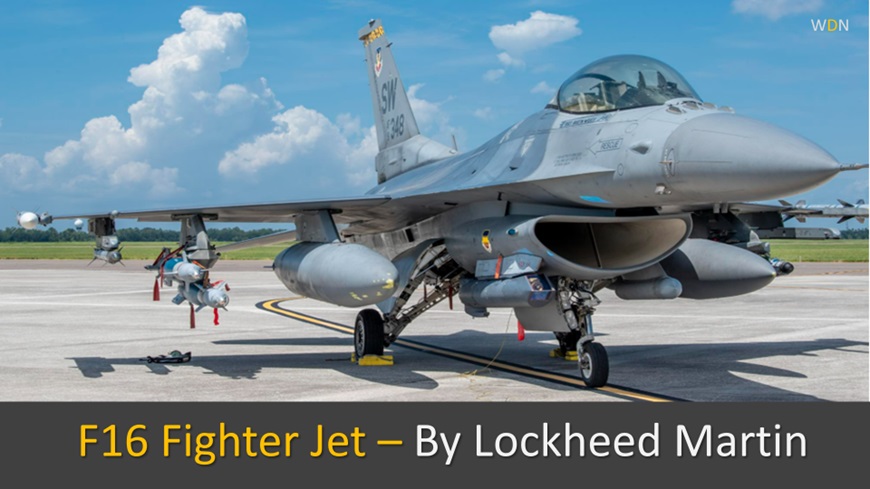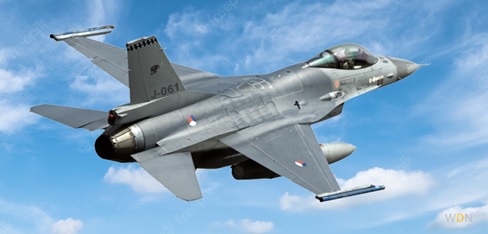
F16 Fighter Jet
Legendary F16 Fighter Jet By US Lockheed Martin
The F16 fighter is a legendary US origin single-engine supersonic multirole fighter aircraft. It is the most preferred widely operated by many countries. It is designed for high-speed, high-altitude, and multi-mission operations.
F16 Fighting Falcon is manufactured by US company Lockheed Martin. It has a wingspan of 32 feet and a length of 49 feet, and it can reach a maximum speed of Mach 2.05 (1,500 mph) at high altitude. The aircraft is powered by a single Pratt & Whitney F100-PW-200 turbofan engine, which provides a maximum thrust of 27,000 pounds.
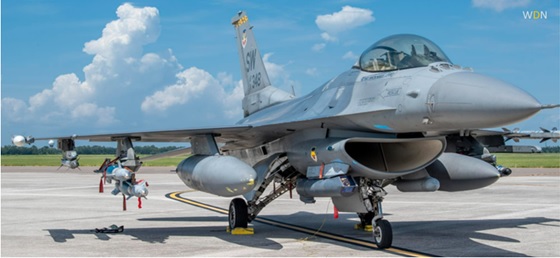
The F16 Fighter is equipped with advanced avionics and weapon package, including a head-up display (HUD), a multi-function display (MFD), an inertial navigation system (INS), and a radar warning receiver (RWR).
The HUD provides the pilot with critical flight information, such as altitude, airspeed, and attitude, while the MFD displays tactical information, such as radar imagery and weapon status. The INS allows the aircraft to navigate autonomously using inertial guidance, while the RWR detects and identifies radar signals emitted by potential threats.
F16 Fighter Jet General Characteristics
General Specifications | F16 Fighter Jet Details |
Designed And Manufactured By | Lockheed Martin |
Generation | F16 Is 4 Plus Generation |
Aircraft Category | Single Engine Light Weight Fighter Jet |
Aircraft Design Type | Cropped delta wing configuration, with a blended fuselage and high-mounted bubble canopy. |
Aircraft Engine Category | Single Engine Fighter Jet |
Primary Designated Role | Omnirole - Multirole , Multi-mission |
F16 Radar Type | F-16E/F is outfitted with Northrop Grumman's AN/APG-80 active electronically scanned array (AESA) radar. |
Sensor Type | Lockheed Martin Unveils Upgraded Sensor Suite for New Production F-16. New variation of the IRST21® (Infrared Search and Track) sensor suite, named Legion-ES™ (Embedded System), is designed for the F-16 Block 70/72 fleet to optimize aircraft performance. |
F16 Variants | F-16A/B Block 15 ADF. , F-16A/B Block 15 OCU. F16 Block 70 is the Latest Varient. F21 a Derivative of F16 is the Latest Varient and completely new varient specially designed and offered to Indian Air Force (IAF). |
F16 Engine / Propulsion | The United Arab Emirates' Block 60 is powered by the General Electric F110-GE-132 turbofan with a maximum thrust of 32,500 lbf (144.6 kN), the highest thrust engine developed for the F-16 |
F16 Weapons / Armaments | The F16 Fighter can carry wide range of AAMs, BVRs, air-to-ground missiles, rockets or bombs; electronic countermeasures (ECM), navigation, targeting or weapons pods; and fuel tanks on 9 hardpoints – six under the wings, two on wingtips, and one under the fuselage. Short Range AAM - AIM-9 Sidewinde. BVR - AIM-120 AMRAAM. |
The AIM-120 AMRAAM is one of the world’s most sophisticated, combat-proven air superiority air-to-air weapon systems. It is a highly refined product with more than 30 years of design, upgrades, testing, and production efforts.
The AIM-120 missile continues to be the preferred aerial combat weapon of choice for many air forces across the globe. Its combat performance and kill capabilities have been fully demonstrated in over 4,900 test shots and combat victories scored during actual aerial engagements in armed conflicts.
F16 Development And Combat History
The F16 Fighter is a single-engine supersonic multirole fighter jet developed for the US Air Force. The F-16 was designed and developed by General Dynamics, which subsequently sold the F-16 Fighting Falcon production line to another important US defense company, Lockheed Martin, in 1993.
The F-16 is the most popular fighter aircraft and serves as the backbone of many air forces around the globe. Currently, over 4600 F-16 fighters are in service with various nations.
In reaction to the losses and experiences of the Vietnam War, the United States Air Force saw the need for a lightweight, agile fighter jet designed mainly for air superiority roles. Colonel John Boyd of the United States Air Force began development on the LWF (Lightweight Fighter). The US air force later on funded this LWF project to develop a prototype based on Boyd’s work .
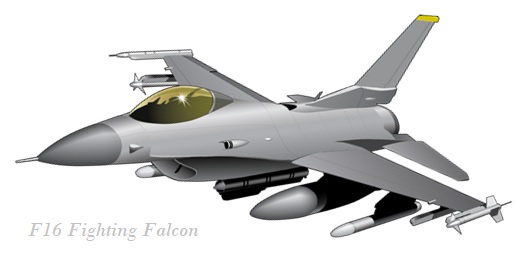
The United States Air Force chose competitive prototyping and issued a request for proposals to construct a LWF prototype. Among the competitors, two contracts were awarded to General Dynamics and Northrop to independently construct the LWF prototype. After the US Air Force chose to proceed with the YF-16 prototype, General Dynamics was named the winner of the Air Combat Fighter competition in 1975.
General Dynamics was awarded the contract to build the first run of fifteen Air Combat Fighters after winning the competition. The first set of F-16s was inducted into the US Air Force on October 1, 1980, and assigned to the 34th Tactical Fighter Squadron. Four European countries made orders for the aircraft during the 1975 Paris Air Show. During the 1975 Paris Air Show, four European countries made an order for 384 F-16s to be manufactured in two new production lines in the Netherlands and Belgium.
F16 Weapons And Armaments
The F-16 Fighting Falcon is a multirole fighter aircraft that can be equipped with a variety of armaments and weapons, depending on the mission requirements. Overall, the F-16’s weapons package is highly versatile and can be tailored to meet a wide range of mission requirements, including air-to-air combat, air-to-ground attack, and reconnaissance missions.
Here are some of the common weapons and armaments that can be found on an F16 Fighter Jet:
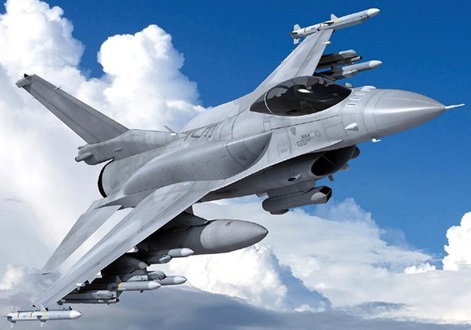
- Guns: The F-16 Fighter is equipped with an M61 Vulcan 20mm Gatling gun that can fire up to 6,000 rounds per minute.
- Missiles: The F-16 can carry a variety of air-to-air missiles, including the AIM-9 Sidewinder, AIM-120 AMRAAM, and AIM-7 Sparrow. These missiles are used to engage enemy aircraft at various ranges.
- Bombs: The F-16 can carry a range of bombs, including free-fall bombs, cluster bombs, and precision-guided bombs. Examples of these bombs include the Mk 82, Mk 83, and Mk 84 free-fall bombs, CBU-87 and CBU-97 cluster bombs, and the GBU-10, GBU-12, and GBU-24 precision-guided bombs.
- Rockets: The F-16 can carry unguided rockets such as the Hydra 70 and the CRV7, which are typically used to attack ground targets.
- Electronic warfare (EW) systems: The F-16 can carry a range of EW systems, including electronic countermeasures (ECM) and electronic support measures (ESM), which are used to jam or intercept enemy radar signals.
- Reconnaissance pods: The F-16 can carry reconnaissance pods, such as the LITENING targeting pod or the Sniper Advanced Targeting Pod (ATP), which can provide real-time video and images of the battlefield.
- Fuel tanks: The F-16 can carry external fuel tanks, which are used to extend the aircraft’s range and endurance.
AIM-9L Sidewinder
Short Range Air-To-Air Air Combat Missile
The AIM-9L Sidewinder is a short-range, air-to-air combat missile used by many militaries around the world, including the United States. It is a development of the earlier AIM-9J missile, and features several improvements in terms of range, seeker sensitivity, and resistance to countermeasures.
The AIM-9L uses an infrared seeker to track the heat signature of a target aircraft. The seeker is mounted on the missile’s nose and is protected by a plastic dome. When the missile is fired, the seeker locks onto the heat signature of the target, guiding the missile to intercept it.
The AIM-9L has a maximum range of about 18 kilometres (11 miles) and can reach speeds of up to Mach 2.5. It is effective against a wide range of targets, including fighter aircraft, helicopters, and unmanned aerial vehicles (UAVs).
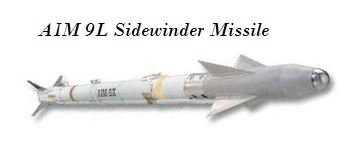
The AIM-9L is also equipped with an improved fuze, which ensures that the missile explodes in the proximity of the target, even if it does not make a direct hit. This feature makes the missile more effective against agile targets that can maneuver quickly to avoid being hit.
Overall, the AIM-9L is a highly effective air-to-air missile that has been widely used in combat. It has been integrated into many different types of fighter aircraft, including the F-15 Eagle, F-16 Fighting Falcon, F/A-18 Hornet, and many others.
AIM-120 AMRAAM
AIM-120 Beyond Visual Range BVR Missile
The AIM-120 AMRAAM Advanced Beyond Visual Range BVR, Air-to-Air Missile (AMRAAM) is a modern, all-weather, beyond-visual-range air-to-air missile used by the United States and its allies. It is designed to engage enemy aircraft at ranges beyond the pilot’s visual range and has a high probability of kill.
The AIM-120 uses active radar guidance to track its target and has a range of up to 100 km (62 miles). It can fly at speeds up to Mach 4 and has a maximum altitude of about 20 km (12 miles). The missile has a solid-fuelled rocket motor and uses a guidance system that combines inertial navigation with mid-course updates from the launching aircraft’s radar and a final active radar homing guidance.
The AIM-120 has several variants, with different capabilities and ranges. The AIM-120A was the first production version and entered service in the 1990s. The AIM-120B added a more powerful rocket motor and improved guidance system, while the AIM-120C added a more advanced radar seeker and a two-way data link. The latest version, the AIM-120D, has an even more advanced seeker and a range of over 180 km (112 miles).
The AIM-120 is carried by a variety of fighter aircraft, including the F-15 Eagle, F-16 Fighting Falcon, F/A-18 Hornet, and F-22 Raptor. It has been used in several conflicts, including the Gulf War, the Kosovo War, and the Syrian Civil War.
Overall, the AIM-120 AMRAAM is a highly effective air-to-air missile that provides a critical capability for air forces around the world. Its long-range and advanced guidance system make it a formidable weapon against any air target.

